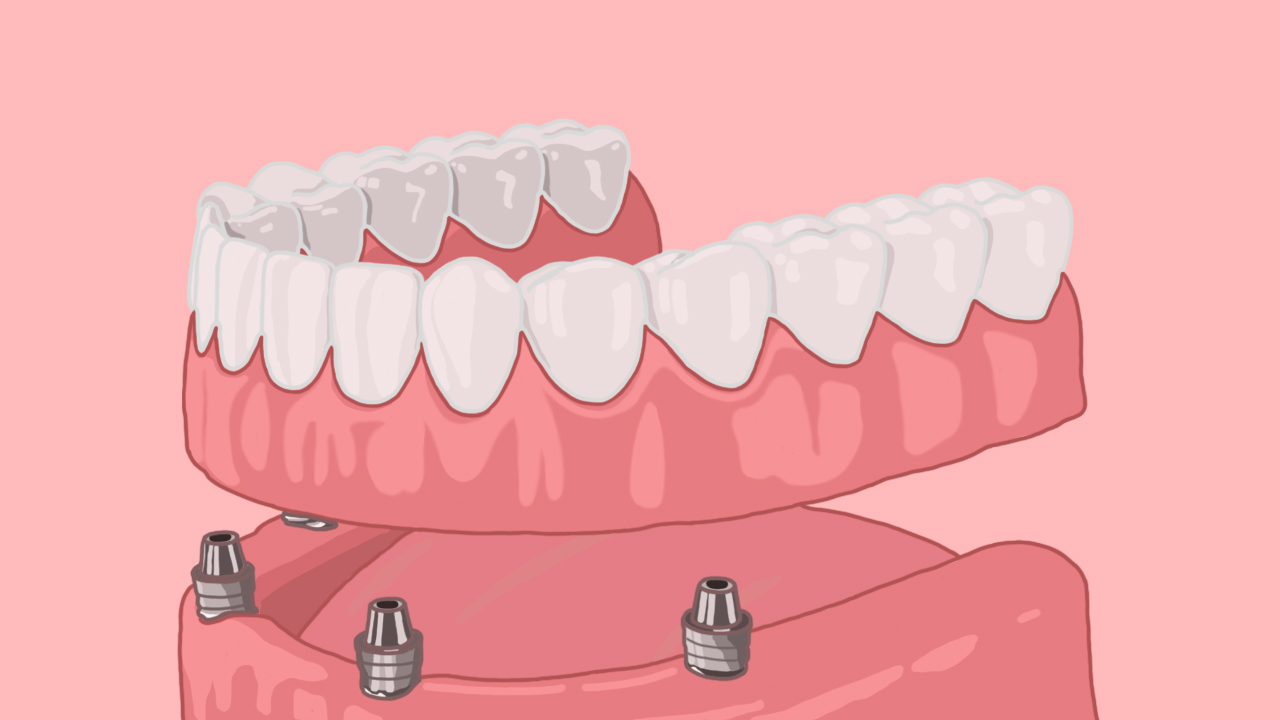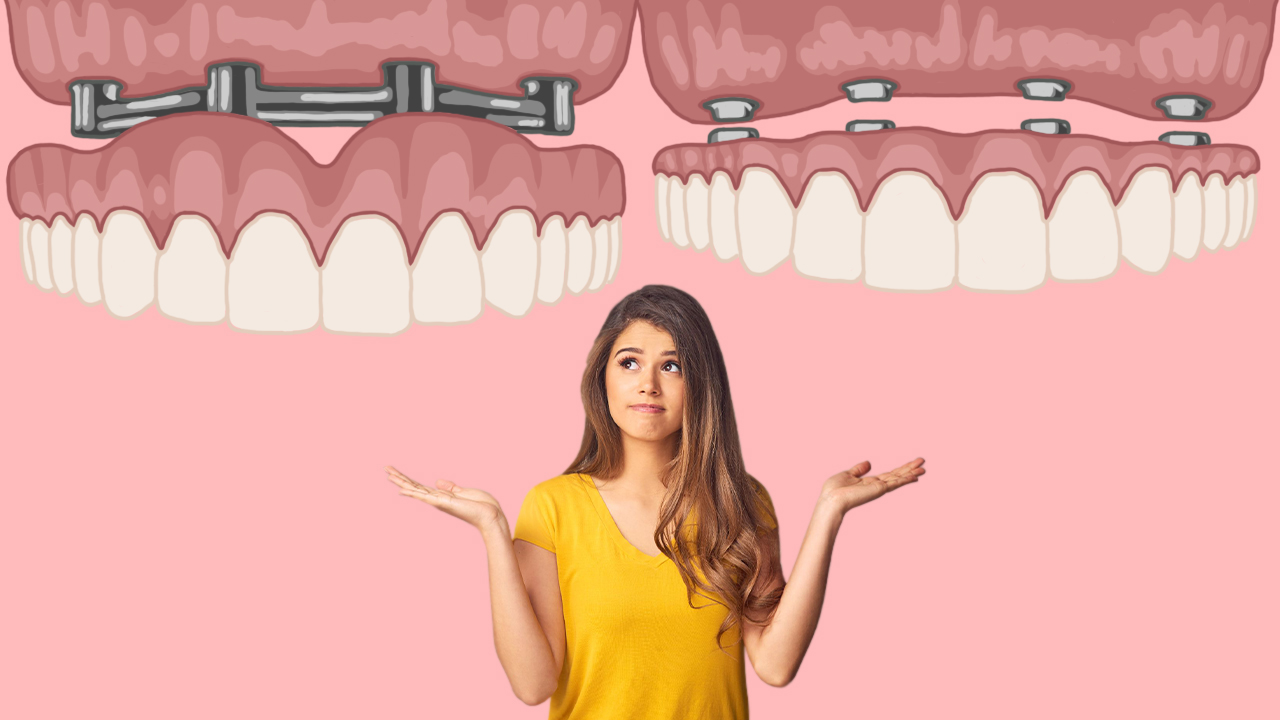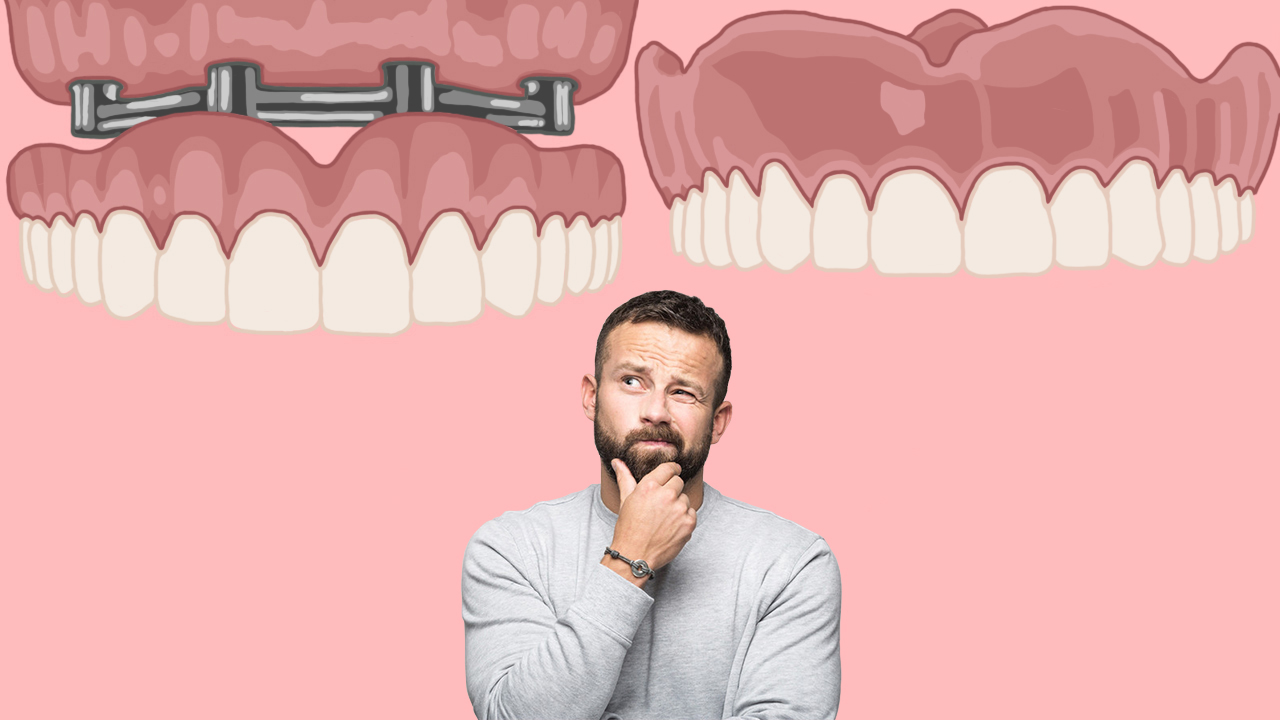Dental implant treatments are one of the most beneficial solutions for replacing missing teeth. All types of treatment are designed to be as aesthetically accurate as possible and to suit different situations.
For example, the amount of teeth you are missing is a prominent factor to consider when choosing implant treatment. Depending on the number of missing teeth you have, your dentist can decide the most ideal solution for you.
Dental implants themselves are small titanium screws that are inserted into the jawbone and serve as the foundation for a chosen replacement. In this article, we will be comparing the restorations used for full-arches of missing teeth.
A full-arch means either the complete top or bottom row of teeth. In some cases, patients may have a full arch of teeth missing and in need of replacement.
You might already know about restorations such as removable dentures and fixed implant bridges. Both of these options have their own set of advantages. However, there is another restoration you may not know as much about, and this is one we wanted to focus on in this article. This restoration is known as an overdenture.
What is an overdenture?

An overdenture is a full set of artificial teeth which looks very similar to a conventional denture. However, it includes a group of sockets which click onto a set of specially designed implants.
This means that despite not having “removable” in its name, overdentures can still be taken out of the mouth and placed back in whenever it suits the wearer.
There are numerous ways you could support an overdenture. You can have an overdenture on just two implants, a higher number of implants or a supporting bar. But whichever way you choose to support an overdenture, this support will allow an overdenture to fit comfortably and securely in the mouth.
We believe that overdentures can be a highly advantageous fix for a full-arch of missing teeth. The best way to discuss these advantages in more detail is by comparing an overdenture to other full-arch restorations. Specifically, we will be looking at fixed implant bridges and removable dentures, and discussing why an overdenture could be a more ideal solution for you.
How to overdentures differ from implant bridges?

Before comparing overdentures with fixed bridges, we will briefly discuss how a fixed bridge works;
In cases of having a full-arch replaced, a fixed bridge comprises of artificial gum tissue and a set of 10 to 12 teeth. A bridge is screwed onto a set of implants (usually four). This means that it stays securely in place.
While a lot of patients prefer to have something as secure as a fixed dental bridge, this also means that you would need a dentist to remove it to check or repair. Along with this, there is also a chance that a fixed dental bridge could break as a result of too much tension. If this does happen, a dentist can unscrew the broken bridge, repair it, and screw it back into place.
But with an overdenture, you have something which is clicked into place rather than screwed. And despite not being as much of a tight fit as a fixed bridge, overdentures still fit securely.
Moving on from how these two restorations fit differently, there are two other notable advantages that overdentures have over dental bridges;
Hygiene
As previously discussed, fixed implant bridges are screwed securely and tightly to the jaw. But when it comes to keeping your oral hygiene in check, this secure fit could prove to be a problem.
It’s no secret that natural teeth and gums need to be kept clean, with the daily routine being to brush twice and floss once. Keeping your teeth clean this way prevents plaque from building up and causing bacteria and food residue to stick to the teeth. This ultimately causes many problems not only for natural teeth but implants as well.
Because the implants used for fixed bridges are covered up by the bridge itself (which can only be removed by a professional), it is very tricky to keep these implants clean.
The gap between the bridge and the jaw needs to be as small as possible, so food does not get stuck in-between. As a result, you cannot remove a bridge independently to keep the quality of your implants in-check.
With overdentures, however, the fact that you can remove them yourself means you can clean the implants regularly and with more ease. You can look for plaque and keep your oral health in check more often.
Aesthetic result
The second point that differentiates overdentures from fixed bridges is the aesthetic result of each restoration. From an aesthetic point of view, fixed bridges are not the ideal solution.
When teeth are lost, the supporting bone and gum will shrink over time. This is what is known as “shrinkage” If left without any prevention, shrinkage could alter the appearance of your facial structure.
With a fixed bridge, it is harder to reconstitute this facial profile. Some form of lip support would be needed to combat shrinkage, and because dental bridges are fixed, they are less feasible in this regard.
On the other hand, both overdentures and removable dentures have what is called a “flange”. A flange is the part of a denture which covers the gum and furthermore, provides support for the lip. Consequently, it is far more possible for shrinkage to be prevented with a denture.
With these points addressed, we can say that in terms of both hygienic and aesthetic areas, overdentures can be a more beneficial solution than fixed dental bridges.
How do overdentures differ from conventional dentures?

Now that we’ve covered fixed dental bridges as a restoration option, we will briefly discuss the function of removable dentures;
A removable (or conventional) full denture is specially moulded to fit around a patients gum-line, instead of using implants to support it. While this is a more straight-forward and cost-effective way to keep replacement teeth in place, it isn’t nearly as reliable as dental implants.
Despite their similarities in appearance, an overdenture can be very different from its conventional, removable counterpart. As we did when comparing them with fixed bridges, we will now list a few examples of how overdentures can be advantageous over removable dentures.
Comfort
The most noticeable difference between removable dentures and overdentures is how each of them feels in your mouth.
Because conventional dentures rely on tightly fitting around your gum-line, they can regularly irritate the gums. More often than not, removable dentures tend to move around in the mouth, causing friction against the gum-line and creating discomfort.
Alternatively, overdentures fit into the mouth by clicking onto implants. This means there is no need for an overdenture to come into close contact with the gum-line. This obviously means that overdentures do not cause the same level of irritation to the gums that removable dentures do.
In addition to being a more comfortable fit, overdentures also fit more securely, which arguably makes them a far more reliable solution.
Functionality
Revisiting the idea of shrinkage, the best solution for this would be an overdenture. We have discussed how an overdenture performs better at preventing shrinkage than a fixed bridge, but it does so better than a removable denture too.
Shrinkage will occur at a more rapid rate if the jawbone is under-stimulated. The best way to stimulate the jaw is by performing simple activities like eating and talking. But because removable dentures have an unfortunate reputation of slipping out, many patients are fearful of moving their jaw too often.
Because overdentures click onto implants to stay in place, they will not slip out of your mouth. This means that you can have a lot more confidence in stimulating your jaw and eating your favourite foods. By doing so, you can easily prevent shrinkage and keep your natural facial profile.
In conclusion, the primary advantage that overdentures have over both of the other restorations is preventing shrinkage far more effectively. We have also established that it can be one of the more comfortable and maintainable of the available options for a full-arch of missing teeth.
The cost of overdentures

If you’re interested in receiving overdenture treatment, you may now be wondering how much it would cost. However, it is difficult to pinpoint a set price for an overdenture without taking into account a few points first.
Firstly, we will revisit the types of support available for an overdenture. You have the choice between just two implants, a higher number of implants, or a supporting bar.
Overdentures can be applied to either the upper or lower jaw. However, you will most likely need to have a minimum of four implants for the upper jaw. This is because the upper jawbone isn’t quite as dense as the lower one. And this could potentially become quite expensive.
But for those who need their lower jaw replaced, the most affordable option would be to have just two implants. This would in-fact work out cheaper than having a fixed dental bridge, and could be considered another advantage.
Despite how an overdenture can initially be more affordable than a fixed bridge, they will also require more maintenance. With the constant clicking in and out of the jaw, the overdenture will become worn. We would recommend that you have an overdenture replaced every 6 months or at least a year. Understandably, some patients may find this inconvenient, and it’s quite possibly the most notable disadvantage of having an overdenture.
You can find out more about the cost of treatments here.
Want to find out more?
In summary, an overdenture is generally a very beneficial solution for replacing a full arch of missing teeth. They are more straight-forward to keep clean than fixed dental bridges and more comfortable and stable than removable dentures. It is also one of the most ideal full-arch solutions available for combating bone loss and shrinkage.
Here at Brighton Implant Clinic, we provide all three of these full-arch treatments. But we strongly recommend the overdenture for more facial profile support and easier cleaning.
If you’d like to discover more about overdentures or have any questions, you can visit our website or contact us.

